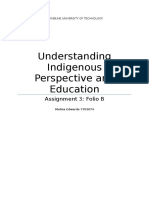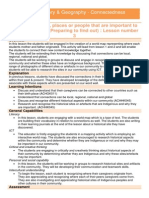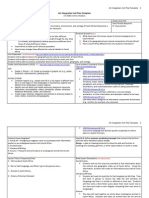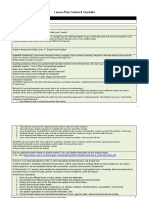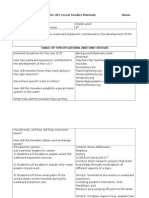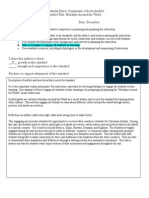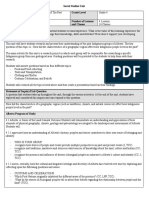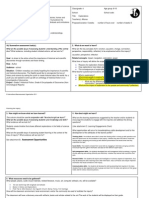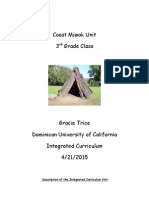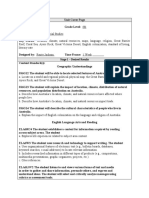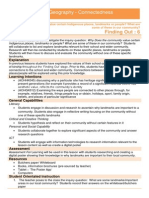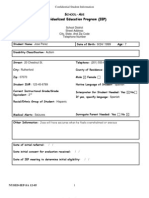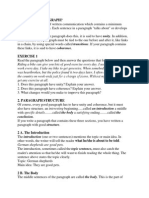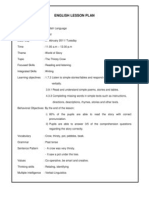Science Unit Planner
Science Unit Planner
Uploaded by
api-221544422Copyright:
Available Formats
Science Unit Planner
Science Unit Planner
Uploaded by
api-221544422Original Title
Copyright
Available Formats
Share this document
Did you find this document useful?
Is this content inappropriate?
Copyright:
Available Formats
Science Unit Planner
Science Unit Planner
Uploaded by
api-221544422Copyright:
Available Formats
UNIT PLANNER
Science overarching idea: Scale and measurement Year Level: 5/6 Sessions: 2 Overall aims of the unit At the end of this unit students will be able/capable of: Understanding how Indigenous cultures use the environment and observation to assist in navigation. Consider different ways to approach problem-solving. Using tools to accurately measure objects and events in the most accurate measurements. Working collaboratively to identify where methods could be improved. Date: 12/03/2013
Students questions selected and referenced answers:
Q: What are some other ways to find my way home using the environment around me? A: Natural sighting techniques: When out to sea in search of land the sight of seals basking on lumps of rocks in the water indicates that land is not far away. Clouds cirrus clouds on display are not a welcome sight, they indicate that a front is approaching. Observing birds habits and habitats. For example the Fulmar breeds in a particular area in mid-May. (Gooley, 2013) Astronomical knowledge and observational data: Observing correlations between the position of the stars and natural events important to the survival of the tribe such as availability of food, onset of particular weather conditions, moral guidance. Eg: Southern Cross makes up Tchingal (The Emu) which at different times of the year indicates the particular part of the breeding cycle the emu is in, therefore acting as a tool to predict season, time of year, and again availability of particular food. (Haynes, 2009) Q: How are Indigenous ways of navigating different to my ways of navigating? A: Indigenous navigation is founded on the concept that our natural world provides information that can be interpreted to determine location and direction. This includes reading the stars, the sun, ocean tides, as well as landmarks such as
rivers, rocks and trees. Indigenous navigational knowledge is passed on through generations using oral communication such as songs and stories, as well as creating drawings and paintings with various symbols. (Kawaharada, date unknown) Contemporary navigation incorporates evolving formats of technology. They use statistics, geographical information and history and equipment such as satellites to provide what is needed to navigate efficiently. Contemporary navigational knowledge is stored within technological equipment, which then allows it to be kept updated and people with appropriate tools (such as phones or computers) are able to easily access it digitally. One of the earliest contemporary navigational tools invented was the compass (in the early 11th century). (Genoun, 2006) Overall relevance of the topic and aims for the students social context and needs: The activities included in this unit are centred on the notion of navigation and orientation and aim to challenge and broaden students pre-assumed knowledge of this topic. This will be achieved by drawing on both indigenous and contemporary methods of navigation that primarily reflect the country in which they live. The topic provides opportunities to draw on a range of navigational practices used in order to foster an appreciation and value for crosscultural and methods. Activities are derived from student-initiated questions and therefore are relevant to their interests and needs. This will assist in the personal development of every day skills and survival techniques.
Teaching approach assigned and short description: Indigenous Knowledge
Indigenous knowledge encompasses the local knowledge of given society and involves the experiences, understandings and interpretations of the local environment. These can include informing practices of agriculture and animal husbandry; hunting, fishing and gathering; struggles against disease and injury; naming and explanation of natural phenomena; and strategies to cope with fluctuating environments. It can be passed on and sustained in culture through various forms, such as traditions, customs, folk stories, folk songs, folk dramas, legends, proverbs and myths. Indigenous knowledge can be integrated into science education, enabling an increased awareness of Aboriginal culture and identity. A bridging of ideas between Indigenous knowledge and Western knowledge can promote a mutual understanding and respect. Moreover, contemporary and environmental issues bring forth social and cultural dimensions which benefit from perspectives other than
Western science, in which Indigenous Knowledge may provide a useful contribution. (Hewson & Ogunniyi, 2011; Aikenhead & Ogawa, 2007; The Living Knowledge Project 2008; United Nations Educational, Scientific and Cultural Organisation, 2002) Key equipment / Key Australian Science curriculum Standard resources: (taken directly from the website): Laptops Important contributions to the advancement of science have been made by people from a range of Butchers paper cultures Pencils and Textas Scientific knowledge is used to inform personal and A4 paper community decisions Fact sheet (see Construct and use a range of representations, appendix 1) including tables and graphs, to represent and Y chart proforma (see describe observations, patterns or relationships in appendix 2) data using digital technologies as appropriate Compass materials; Suggest improvements to the methods used to - Template (see investigate a question or solve a problem appendix 3) - pen - ruler - magnet - 1 pin - sticky tape - bowl - water Session 2 Booklet (see appendix 4)
Key vocabulary: Navigation Scale Measurement Formal/ informal units of measurement Distance Direction Indigenous Alternative methods/tools Environment Observations Landmarks Map Symbols Verbal instruction (songlines) Stars/ Sun/ Sky
SESSION 1 Learning outcomes: Students will explore their own understandings of navigational methods and work collaboratively to construct knowledge and implement the use of indigenous navigational methods. Students will identify various indigenous observation strategies used to measure distances and spaces.
Specific activities session 1 Tuning in: Students will discuss following questions: What is the smaller thing you can think of? What is the largest thing you can thing of? What is the closest thing to you and the furthest thing from you?
Students will explore Scale of the universe website and return to questions previously discussed. Engage: Students Explore: Students will use observation to explore and discover a hidden destination with a group. Students will be briefed on behavioural expectations and physical boundaries before leaving the classroom. Students will be divided into two groups. Students will draw on observation skills/landmarks to navigate around floor guided by teacher. Students will create a set of directions using symbols and colours for a group to find the chosen destination on level 3, marked with an X. They will use a variety of methods discussed during the brainstorm to collaboratively design a map. Groups will switch directions with another group, using the map to search for the hidden destination. will brainstorm how the environment helps us to navigate (without technology), explore terms you might use. How do you find your way around? What things could you use to help you? If you didnt have a compass, GPS, iPhone or any technology to help, how could you find your way? Discuss, expand. Students will lead an orientating walk around the university floor. Encourage students to point out significant landmarks to find the way back to the classroom. Students will return with partner and design a simple map using the landmarks observed to reach destination. Students are free to utilise methods of their choice.
Explain and elaborate Students will discuss strategies employed to navigate level 3. Students share feedback on the effectiveness of the map they were given and how could it be improved.
Students will receive a fact sheet (see appendix 1) to read through and identify indigenous methods of navigation. Discuss similarities and differences between their map and indigenous methods of navigation (give examples to build on initiated ideas, prompt if necessary).
Evaluate Students will consider individually what they would like to learn more about alternative methods of navigation using the environment. Students will, using a Y Chart (see appendix 2) note: three things they learnt today, two things they would like to learn more about and one question they have. Invite students to share ideas and further questions.
SESSION 2: (Self guided) Student question1: What are some other ways to find my way home using the environment around me? Student question 2: How are Indigenous ways of navigating different to my ways of navigating? Learning outcomes: Students will investigate alternative methods of navigation using the environment. Students will examine a maps key features (for example, landmarks, north, east, south, west, and scale). Students consider the purpose of a compass and create their own. Specific activities session 2 Type of work: individual or in groups? A combination of small group and individual work Instructions for the students to follow: Step 1: Students to read and briefly reflect on activity booklet (see appendix 4). Step 2: Students commence Part A of instruction sheet (reading the story appendix 4, page 2). Step 3: Students record the main points found in the story Step 4: Individually, students will investigate the following questions using information drawn from story and map (appendix 4, page 3-4) provided. How do the people in the story use the environment to work out where they are?
What methods do Indigenous people use the sky to help navigate the land? On the map, indicate where North, East, South and West are located. Imagine you are lost and have ended up on the red dot on the map. You need to find your way back to school, in what direction will you need to walk? Find a partner who has also finished responding to the questions. Share and discuss any interesting things that you found. Consider any landmarks on your map that you could use to help recognise the way back to school.
Step 5: In pairs, students explore contemporary methods of navigation such as using a compass. They recall prior knowledge and share this with their partner. Step 6: With the same partner, students will create a compass. (instructions on page 5 of appendix 4. Student will also need a copy of appendix 3) Step 7: Using compasses, student will investigate the orientation of different areas of the school (eg. classroom door, library) Closure: As a group, students will share an aspect of the lesson that they found interesting. Early Finishers: Investigation - what would you call the direction if it wasnt directly on North or East but in between? Tidy and pack away resources. Students to keep compass for future use.
You might also like
- FinalNurses Day MC Script - 2017Document6 pagesFinalNurses Day MC Script - 2017Luqman Hakim88% (8)
- PYP PLANNER (WHERE WE ARE IN PLACE AND TIME) THEME 2020 (Grade 1 and Grade 2)Document8 pagesPYP PLANNER (WHERE WE ARE IN PLACE AND TIME) THEME 2020 (Grade 1 and Grade 2)Ina50% (2)
- Assignment 3 - Folio and ReflectionDocument14 pagesAssignment 3 - Folio and Reflectionapi-339908787100% (1)
- Where We Are in Place in Time 1 17 13Document4 pagesWhere We Are in Place in Time 1 17 13api-147600993No ratings yet
- PYP Planner Sharing The Planet PDFDocument4 pagesPYP Planner Sharing The Planet PDFIman Mansour100% (1)
- Unit of Inquiry Yr4Document7 pagesUnit of Inquiry Yr4Nishu JainNo ratings yet
- How The World WorksDocument4 pagesHow The World Worksapi-147600993No ratings yet
- Analyze Learners: "Basic World Geography" 2 Grade Geography Lesson Length: 180 Minutes, or Three Class PeriodsDocument4 pagesAnalyze Learners: "Basic World Geography" 2 Grade Geography Lesson Length: 180 Minutes, or Three Class Periodsapi-337364062No ratings yet
- PE-4-FINAL-RUBRICS and GUIDELINES-VOLLEYBALLDocument2 pagesPE-4-FINAL-RUBRICS and GUIDELINES-VOLLEYBALLAlaineNo ratings yet
- RPH Bi PraDocument3 pagesRPH Bi PraCik Seumdwa82% (17)
- NSLI Y 2017-18 Application Sample PDFDocument38 pagesNSLI Y 2017-18 Application Sample PDFOmar AbdiNo ratings yet
- st1 Geography Around World FinalDocument4 pagesst1 Geography Around World Finalapi-260443196No ratings yet
- WorldgeoDocument2 pagesWorldgeoapi-293134952No ratings yet
- GeographyunitDocument16 pagesGeographyunitapi-267275160No ratings yet
- 0 FiinnaalllDocument9 pages0 Fiinnaalllapi-264952803No ratings yet
- UnderstandinggeographyDocument4 pagesUnderstandinggeographyapi-355180119No ratings yet
- Lesson Plan 3Document3 pagesLesson Plan 3api-261801340No ratings yet
- Lesson 1 TableDocument1 pageLesson 1 Tableapi-334184183No ratings yet
- Kremmel ArtintegratedunitDocument4 pagesKremmel Artintegratedunitapi-254251035No ratings yet
- Unit Plan P I II Final Draft 2 Our VersionDocument19 pagesUnit Plan P I II Final Draft 2 Our Versionapi-248716727No ratings yet
- Previous Exam Answers ENG1502Document6 pagesPrevious Exam Answers ENG1502Tshilas33% (3)
- Ipts 1Document4 pagesIpts 1joe_delinskiNo ratings yet
- Emerging Tech ProposalDocument7 pagesEmerging Tech Proposalapi-251645446No ratings yet
- Egp 335 Rhode Island ColonyDocument7 pagesEgp 335 Rhode Island Colonyapi-304899472No ratings yet
- Lesson Plan Profile A Country 1Document3 pagesLesson Plan Profile A Country 1api-479660639No ratings yet
- His Lesson Plan AboriginalDocument10 pagesHis Lesson Plan Aboriginalapi-308348920No ratings yet
- Edit 610 - Final ProjectDocument9 pagesEdit 610 - Final Projectapi-688873827No ratings yet
- Previous Exam AnswersDocument6 pagesPrevious Exam AnswersCharmaine Verrall97% (36)
- Social Studies Unit For EDU 383 Social Studies Methods Name - Jamie ReavesDocument10 pagesSocial Studies Unit For EDU 383 Social Studies Methods Name - Jamie Reavesapi-299994443No ratings yet
- Unit Plan ScheduleDocument9 pagesUnit Plan Scheduleapi-260571971No ratings yet
- Integrated Geography and Science and Technology Sample Unit The Earth's Environment Stage 2 Duration: One Term (10 Weeks)Document5 pagesIntegrated Geography and Science and Technology Sample Unit The Earth's Environment Stage 2 Duration: One Term (10 Weeks)api-326756828No ratings yet
- Final Project PBL Unit PlanDocument20 pagesFinal Project PBL Unit PlanAshtouroNo ratings yet
- Rabb Kimberly Lessonplantemplate-Iste-2022Document6 pagesRabb Kimberly Lessonplantemplate-Iste-2022api-666432385No ratings yet
- Unit Plan-ScienceDocument4 pagesUnit Plan-Scienceapi-247971411No ratings yet
- Kindergarten Social Studies LessonDocument6 pagesKindergarten Social Studies Lessonapi-185987237100% (2)
- WebsiteDocument2 pagesWebsiteapi-285786847No ratings yet
- Ecological FootprintDocument3 pagesEcological Footprintapi-318168964No ratings yet
- Iowa Teaching Standard #3 - Demonstrates Competence in Planning and Preparing For InstructionDocument1 pageIowa Teaching Standard #3 - Demonstrates Competence in Planning and Preparing For Instructionapi-297195256No ratings yet
- Where We Are in Place and TimeDocument5 pagesWhere We Are in Place and TimePushpita Nandy100% (1)
- CEP Lesson Plan Form: Colorado State University College of Health and Human SciencesDocument5 pagesCEP Lesson Plan Form: Colorado State University College of Health and Human Sciencesapi-382280635No ratings yet
- How The World WorksDocument3 pagesHow The World Worksapi-250808296100% (1)
- Social Unit PlanDocument20 pagesSocial Unit Planapi-489862967No ratings yet
- Edfd452 Evidence - Edss341 A3Document21 pagesEdfd452 Evidence - Edss341 A3api-358837015No ratings yet
- Edfd452 Evidence - Edss341 A3Document21 pagesEdfd452 Evidence - Edss341 A3api-358837015No ratings yet
- Grade 7 Interdisciplinary Unit ChartDocument3 pagesGrade 7 Interdisciplinary Unit Chartapi-299824541No ratings yet
- Field Based LearningDocument7 pagesField Based LearningJanaky VasuNo ratings yet
- NETS - T Standards Power PointDocument7 pagesNETS - T Standards Power PointGeorgetteNo ratings yet
- Where We Are in Place and Time Grade 3 4 Sy 2012-2013Document8 pagesWhere We Are in Place and Time Grade 3 4 Sy 2012-2013api-264373083100% (2)
- Map UnitDocument32 pagesMap UnitJohn OrsbornNo ratings yet
- Geography SyllabusDocument48 pagesGeography Syllabusapi-277897156No ratings yet
- Coast Miwok Unit 3 Grade Class: Description of The Integrated Curriculum UnitDocument11 pagesCoast Miwok Unit 3 Grade Class: Description of The Integrated Curriculum Unitapi-269754690No ratings yet
- Educ 380 Smart Board Lesson Plan FinalDocument5 pagesEduc 380 Smart Board Lesson Plan Finalapi-269883388No ratings yet
- Learning SequenceDocument7 pagesLearning Sequenceapi-247416806No ratings yet
- Australia Unit PlanDocument17 pagesAustralia Unit PlanrjackstarNo ratings yet
- Kesler - Community UnitDocument59 pagesKesler - Community UnitJaclyn Fuchs KeslerNo ratings yet
- Uncovering AboriginalDocument8 pagesUncovering Aboriginalapi-310317268No ratings yet
- 001-208813 35409512 100033239 Assessment Three EDU80001-AT3Document14 pages001-208813 35409512 100033239 Assessment Three EDU80001-AT3anjumNo ratings yet
- Scope and Sequence of Five Lessons FinalDocument10 pagesScope and Sequence of Five Lessons Finalapi-260503527No ratings yet
- Geography SyllabusDocument61 pagesGeography SyllabusdawnparkNo ratings yet
- Lesson For EdtDocument5 pagesLesson For Edtapi-252416072No ratings yet
- Digital Unit Plan TemplateDocument4 pagesDigital Unit Plan Templateapi-269321110No ratings yet
- Lesson Plan 6Document2 pagesLesson Plan 6api-261801340No ratings yet
- Earth Unit - Grade 1Document93 pagesEarth Unit - Grade 1Morgan BaydaNo ratings yet
- A Model of Adaptive Language Learning (MLJ 2006)Document23 pagesA Model of Adaptive Language Learning (MLJ 2006)marcosNo ratings yet
- Grade Lesson - Self Introduction: ST ND RD THDocument2 pagesGrade Lesson - Self Introduction: ST ND RD THArabella Madeline Tuason Las-igNo ratings yet
- Introduction To Statistics (Week 1)Document31 pagesIntroduction To Statistics (Week 1)Yvi BocaNo ratings yet
- IEPDocument14 pagesIEPAndrea BarrosoNo ratings yet
- DLP q2 Week I-9 - Per DevDocument3 pagesDLP q2 Week I-9 - Per DevMelegin RatonNo ratings yet
- Scavenger Hunt #1 Finding Answers To Common Writing QuestionsDocument10 pagesScavenger Hunt #1 Finding Answers To Common Writing QuestionsVvadaHottaNo ratings yet
- John Carroll University Magazine Fall 2006Document60 pagesJohn Carroll University Magazine Fall 2006johncarrolluniversityNo ratings yet
- Manipon Asmt3 Lesson1Document10 pagesManipon Asmt3 Lesson1api-353386229No ratings yet
- Ice BreakerDocument4 pagesIce BreakerPuche Mara100% (1)
- Unit Plan Ca Coute CombienDocument2 pagesUnit Plan Ca Coute Combienapi-226502867No ratings yet
- Assessment Task 2 DDT - Portfolio IntroductionDocument4 pagesAssessment Task 2 DDT - Portfolio Introductionapi-405311224No ratings yet
- Paragraph Writing NotesDocument10 pagesParagraph Writing Notesswapnil8158No ratings yet
- HTTP WWW - Cimghana.org Assets File Downloads GSM Brochure Jan 2010Document9 pagesHTTP WWW - Cimghana.org Assets File Downloads GSM Brochure Jan 2010Ian BlackburnNo ratings yet
- KRA's Objectives Timeline Weight Per Kra Performance Indicators (Quality, Efficiency, Timelines)Document6 pagesKRA's Objectives Timeline Weight Per Kra Performance Indicators (Quality, Efficiency, Timelines)lokowako18No ratings yet
- Weebly Lib 500Document14 pagesWeebly Lib 500api-313526738No ratings yet
- Lesson Plan in TOSDocument10 pagesLesson Plan in TOSJonahEsporas0% (1)
- Jewish Standard, April 20, 2018Document68 pagesJewish Standard, April 20, 2018New Jersey Jewish StandardNo ratings yet
- Madeline Hunter - 8 Steps of Lesson PlanningDocument1 pageMadeline Hunter - 8 Steps of Lesson Planningapi-421124069No ratings yet
- Quarterly Exam Schedule GRADES 4-10 Feb.8-11Document4 pagesQuarterly Exam Schedule GRADES 4-10 Feb.8-11Jhomar LatNo ratings yet
- Teaching English For Young LearnersDocument9 pagesTeaching English For Young LearnersDinda Farahdilla100% (1)
- Genuis HourDocument21 pagesGenuis Hourapi-300978551100% (1)
- Mathematical Association of AmericaDocument12 pagesMathematical Association of AmericaJuanNo ratings yet
- Pre-Philosophy StatementDocument3 pagesPre-Philosophy Statementapi-515161290No ratings yet
- CCI - TQ New Centre Application Form V1.0Document19 pagesCCI - TQ New Centre Application Form V1.0amirlandaNo ratings yet
- English Lesson PlanDocument3 pagesEnglish Lesson PlanNur Farhanah50% (2)


